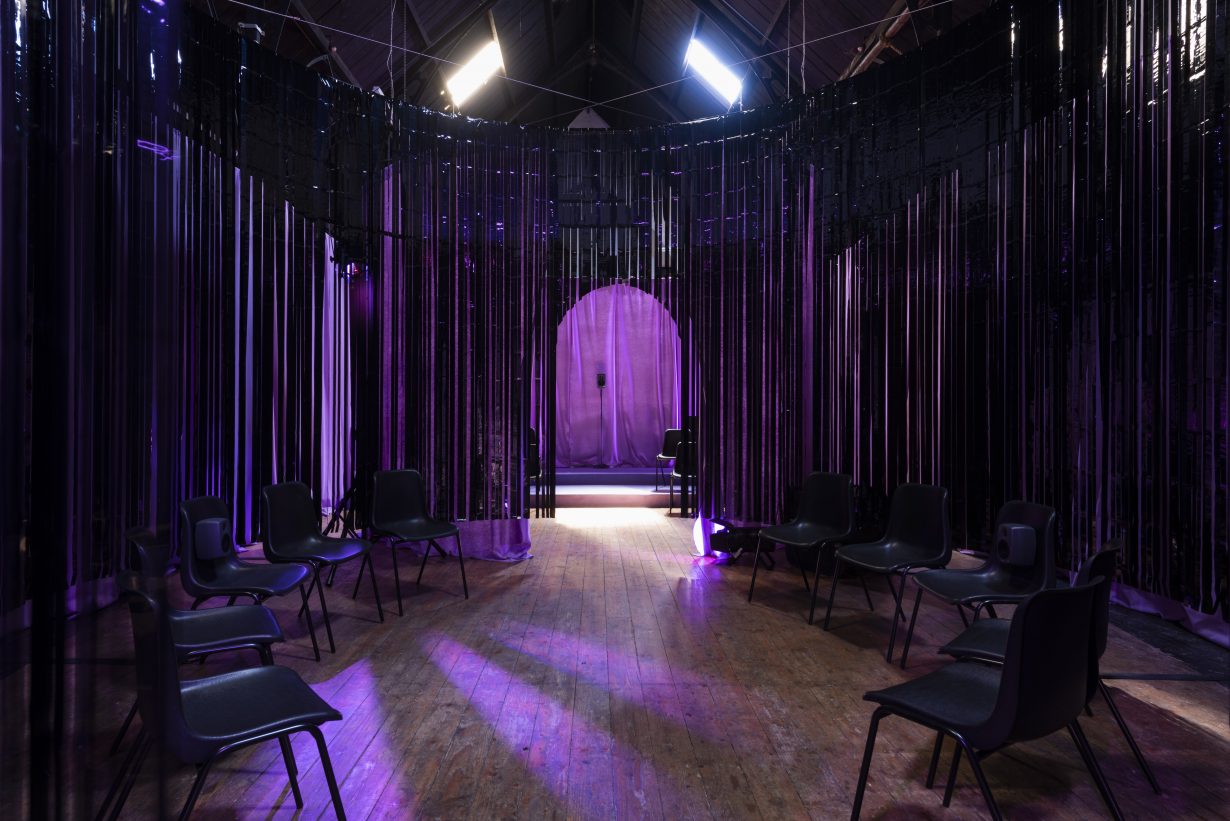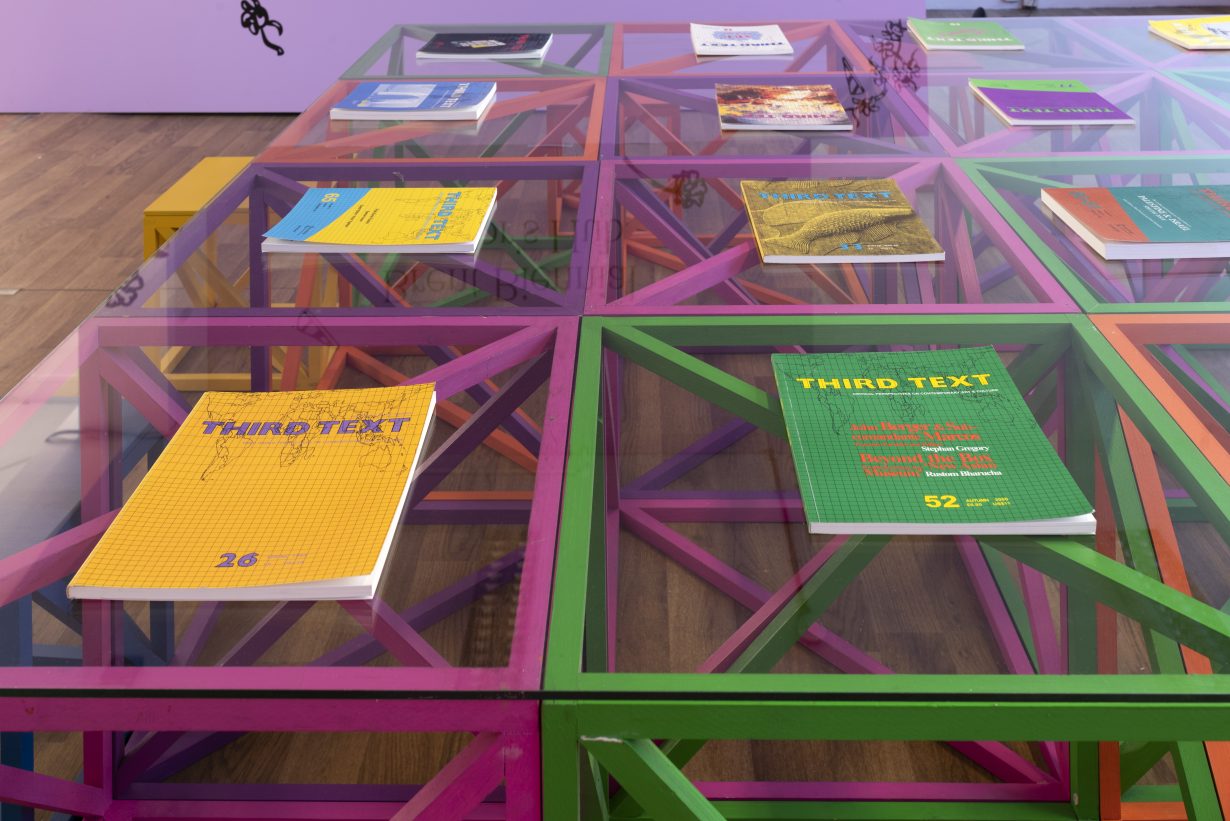In partnership with the Brent Biennial, ArtReview publishes the second of two reflections on the London exhibition
‘…..Creation,
the world we receive and the world that we make,
is all anyone can claim to know.
The rest is just commentary…
Come, you are my guest here.
Let me offer you this small truth.’
– Ezra Green
This year’s edition of the Brent Biennial, titled In the House of my Love, was named after a line from ‘A Poem to the Nationalist Marcher (for the queer people of Warsaw)’ by New York-born contemporary poet Ezra Green. In it, Green extends an invitation to a nationalist marcher transforming their hostile occupation of the shared space between them into an offering of hospitality: ‘you are a guest now / in the house of my love’.
I write as a guest who has been invited to give a commentary on the biennial, but I also write as someone who wants to be, as Green invites me to be, ‘true to the presence that surrounds them’. I want to ask myself as I write: is it possible for me, to be both true to the presence that surrounds me, and to turn my full attention towards something so full of love?
In Playing in the dark (1993) Toni Morrison describes her experience of coming to know how the white literary imagination functioned to form the essential (white supremacist) characteristics of the American literary tradition. Describing a fish swimming in a bowl, she evokes the sense of a structure hiding in plain sight, one ‘that transparently (and invisibly) permits the ordered life it contains to exist in the larger world’. If there was something that has shaped the UK’s cultural imaginary related to art and culture it must surely be attitudes to immigration. At the same time as policy decisions to ‘control’ and ‘manage’ immigration suggest a ‘pure’ Britishness, local and national cultural policy and output mobilise narratives of metropolitan multicultural ‘vibrancy’ and ‘diversity’ to attract investment and cultural capital.
Such arts activity can seek to be soft touch and ‘arms length’ – smoothing out politically created divisions into community ‘cohesion’, ‘integration’ or ‘harmony’ or they might be more sophisticated spectacles of liberal knowingness. The latter might make nonperformances of disapproval against racism and xenophobia but fail to reflexively consider how the material machinations of the systems that enable these disapprovals exist primarily to provide more cultural capital for individual artists or institutions, and beyond the empty gesture of representation or memorialisation are consistently ill equipped to provide meaningful autonomy to those most impacted by structural inequality. If we are artists and art workers with political desires, we know that these imaginaries form the glass bowl and the water in which so much artistic activity takes place, we have come to know, as Morrison did, that ‘the subject of the dream is the dreamer’. The question we might ask – if we permit ourselves our own dreams – is will the shape of the bowl change? Will it explode? Will everything spill everywhere? Or will the bowl simply hold as we are distracted by our reveries or training our eyes on different dreams still contained by the dominant dreamer?

In her book Abolitionist Intimacies the poet and activist El Jones grapples with the emotional messiness of desire in a world that hasn’t changed: ‘it is not that we want to persecute desire. It is that we want those things not to have to be desired, because they are a given.’ If we are not reformers concerned with institutional tinkering but abolitionists who want an arts infrastructure that is compatible with the very necessities of existence – stable housing, work practices which can provide autonomy for the many not the few, an education that is free and freed from capitalist logics – our work exists sometimes in the binaries of love and fear. Fighting for things we wish we already had, it can sometimes feel that our love might run out, and this fear can numb the very desires that feed our energies to continue participating.
This summer a pocket of possibility opened up in Brent, the second most ethnically diverse boroughs in London. It is a local authority containing one of the highest numbers of first-generation immigrants in the country with an ongoing history of grassroots resistance and mutual aid organising, and an area of London where culture happens across the many spaces that life does, rather than siloed in a cluster of institutionalised arts spaces. Yet as the curators of the Brent Biennial held open a loving possibility for art making and showing otherwise, I found myself unable to turn my attention there. Exhausted by participating in what adrienne maree brown has called ‘the imagination battle’ that living in the city of my birth so often feels like, I spent the summer avoiding my phone, retreating from ‘art’ and trying to escape into ‘life’.
In a performance statement from 1983 Lorraine O Grady writes about her need to find a true audience for her work: ‘work cannot exist alone, anymore than the artist can’. In order for a work to come ‘into existence’ it needs ‘“preservers”, a combination of presenters, critics and audience …who need the work in order to be themselves’ (my emphasis). This description of the physical and emotional osmosis between art, artwork, curator, critic, audience, artist, is a flow of energy that I know is possible: I have felt it, but sometimes I also feel… a glitch.

Zinzi Minott describes each part of her five-part series Fi Dem (2018–), shown as part of the biennial at Newman Catholic College in Harlesden, as an ‘iteration … a filmic manifestation of a year lived, a body moved and moving through a reflection on the legacies of The Windrush Generation’. Through use of the glitch Minott evokes the hypervigilance that has us doubling back, checking, rechecking, describing, analysing, the one that slows us down, stops us from moving. Minott reminds us glitches have histories, and I think of these histories when I find myself looping two questions during conversations with friends from the city I was born and raised in, friends also alienated by their gentrified neighbourhoods and the ways their jobs within and around art and academic institutions morph them into conforming into shapes they don’t recognise. At what point is a place no longer ours? At what point are our skills no longer useful for the desires we have? Sitting in a reading room at Metroland Cultures in Kilburn populated by the first 100 issues of Third Text, Rasheed Araeen’s art and culture journal founded in Brent in 1987, I know again something I already knew: that these questions about displacement have been asked before. Surrounded and held by Araeen’s signature seating and tables made up of lines moving in different directions that form cubes, I am literally aware of the space being structured by unresolved questions, even as I hold in my hands hundreds of attempts to resolve them.
The unresolvable question of “what does a Biennial mean in Brent?” is circled around by the curatorial team in the opening pages of the printed programme to this edition. Accompanied by a fisheye image of the collective, taken from above, the team appear both smaller and larger inside the boundaries of the circle they are framed in. None of their questions about biennials, artworld gentrification of the city and the self, or indeed the usefulness of the separation between art and life are ever resolved, and each of their different experiences add new layers of complication. At various points the curators talk about ‘seeding’ for the future (for new dreamers) but their conversation and the works that moved me most at the Biennial open the door to ideas more akin to a different permaculture metaphor. In their book We Are ‘Nature’ Defending Itself: Entangling Art, Activism and Autonomous Zones, artists and activists Jay Jordan and Isabelle Fremaux describe how ‘in a compost pile everything is cross contaminating, nothing is pure’, each element is degrading together at the same time as ‘nourishing and transforming each other … [towards] fertility’. This image of creative renewal through heterogeneity is echoed in a programme that layers different histories and genealogies and frames them in a set of immigrant, feminist and queer traditions (of which art making is just one) which in their material commitment to navigating hostility must also navigate the delicate equilibrium between solidarity, incompatibility, mutual aid and survival, coalition and self-determination.

The holding open of questions instead of closing in on answers felt like a consistent invitation across the twelve commissioned artists’ projects in ways that left room for new relationships to old narratives outside of the disappointments of either/or. The ongoingness of displacement was given space, light and air in the works in ways that allowed me an opportunity to find a new relationship to ideas of inheritance. In Arwa Aburawa & Turab Shah’s video work I carry it everywhere with me (2022), based on interviews with first generation immigrants in the borough, intergenerational experiences of displacement melt into each other even as they retain their individual specificities; neither experience is erased, each can sit with one another, witness one another even if each one cannot heal the other. Ed Webb-Ingall’s imagining and creation of an archive and radio play to recreate the sensorial experience of attending the first meeting of Mosaic, a charity set up in the year 2000 in Brent to support Gay and Bisexual Men, expanded the idea of legacy, away from patriarchal desire for a place in the historical record, into a speculative layering of queer imagining.
In Shenece Otretha’s installation and sound work In Counter Harmony (2022) the voices of people talking, gathering, singing, partying are a record of the stories of physical displacement. Arriving into the fabric folds of the installation’s amethyst protection, I found also a living record of embodied ‘sensorial displacement’ (a term urbanist Leslie Kern uses to mark the loss of the ‘sights, sounds, smells, tastes, and feelings’ of a place) wrought by disinvestment in communal spaces that are not reliant on consumption. Sat down with a circle of empty chairs around me, but in the company of many voices who longed for other places and ways to be, I also sat with the long history of my longing for connection in the place I live that is a continuation and also a variation – a counter harmony – to that which I have inherited from my family, and before that my ancestors.
In my final moments at the biennial I lay down in Rebecca Bellantoni’s installation and video work You have any peace for me? C.R.Y. I wondered why I had taken all summer to find my way there, why in this city, and in cultural work, it is so easy to pretend that we are alone? In the darkness of the piece I felt witnessed and held, my own emotional release radiating into the space of the installation, shimmering, a glimpse, unrecorded, but remembered by the space Bellantoni opened out to me.
The film has already started when I arrive and so as I lie, and with eyes full of tears, I watch Bellatoni walk around and dance in her city that is hers and not hers, her body reminding my body it can do the same.
It is only at the end that I hear the song she sings at the beginning.
‘Open
Open
Open up your heart
And let Jah’s love shine through.
For what you give,
shall return to you.’
Jemma Desai is a writer based in London.
The Brent Biennial: In the House of my Love took place in London, 8 July – 11 September 2022. This is the second of two texts reflecting on the exhibition. Francis Whorrall-Campbell’s essay can be read here.
